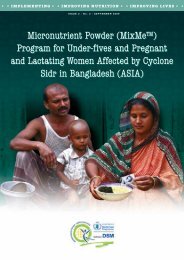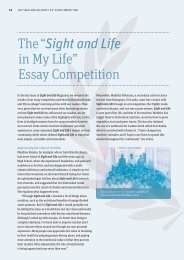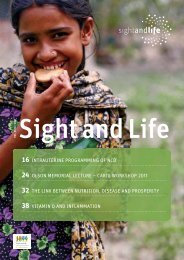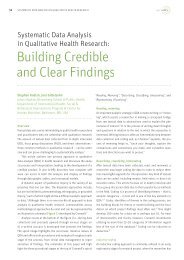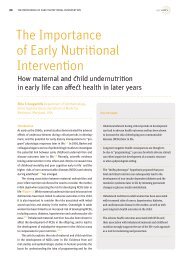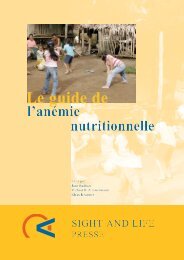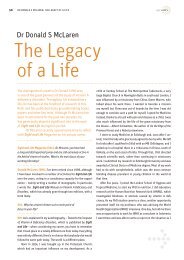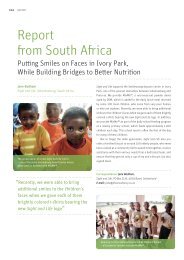Sight and Life Magazine 1/2011
Sight and Life Magazine 1/2011
Sight and Life Magazine 1/2011
Create successful ePaper yourself
Turn your PDF publications into a flip-book with our unique Google optimized e-Paper software.
50 IRON FORTIFICATION – NEW REVELATIONS?table 4: Total numbers of bacteria in control <strong>and</strong> iron groupafter 6 months iron supplementation ¹Control Group¹ Data shown are mean (SE) log number of bacteria/g fecesIron GroupBaseline 11.29 (0.67) 11.62 (0.94)6 Months 11.28 (0.81) 11.78 (0.59)table 5: Comparison of main bacterial groups in feces of Ivorianchildren <strong>and</strong> young European adultsBacterialIvorian children Young European adultsgroupBacteroidesEnterobacteriaBifidobacteriaLactobacilliData for Ivorian childrenfrom reference Log numberbacteria/g feces1087.56.5from reference 3 <strong>and</strong> forLog numberbacteria/g feces9.25.99.26.7European adultsof enterobacteria by a further 100 million (log numbers 7.8 to8.3 bacteria/g feces) while reducing the proportion of lactobacilli(Figure 2). If these changes in enterobacteria <strong>and</strong> lactobacilliare expressed as percentages of the total number of bacteriain the microbiota, there is a four-fold increase in enterobacteriafrom 0.01 to 0.039%, while there is a fourfold fall in the proportionof lactobacilli from 0.004% to 0.001%. There was also afall in bifidobacteria, but this was not significant.Reasons why iron favored the growth ofenterobacteria over lactobacilliIron is a nutrient which is essential for the growth of most bacteria,but not in the case of most Lactobacilli spp (Table 3). Mostenteric gram-negative pathogens, including Salmonella spp,E.coli <strong>and</strong> Shigella spp, 18 take up iron-siderophore complexesby specific outer membrane receptors <strong>and</strong> display increasedvirulence in situations of increased iron availability. 32 It is alsointeresting to note that fecal lactoferrin is as good an indicatorof gut inflammation as calprotectin. 33 Lactoferrin is a powerfuliron-binding protein that is particularly effective under acid conditions<strong>and</strong> is derived from the polymorphonuclear neutrophilsthat are drawn into the gut lining at the onset of inflammation.Whether the neutrophil lactoferrin depresses pathogen growthat the mucosal lining is not known, but bacterial growth in themicrobiota will be limited by iron availability, <strong>and</strong> the additionaliron provided by the supplement may have provided a growthadvantage for the enterobacteria, which enabled them to increasecell numbers at the expense of the lactobacilli <strong>and</strong> possiblythe bifidobacteria.The potential hazards of iron loading are well recognized. 34Not only do we have the results of the recent study in Pemba 1but it has previously been noted that iron given to patients withquiescent tuberculosis appeared to reactivate the disease. 35 Inaddition, Murray <strong>and</strong> colleagues noted that, in areas of hyperendemicPlasmodium falciparum, patients with clinical irondeficiency enjoyed an attenuated incidence <strong>and</strong> severity of malariabut when such subjects were fed an iron-replete diet, manyexhibited a recrudescence of malaria 36 <strong>and</strong> when iron-deficientMaasai pastoralists were treated with iron, there was an increasein amebiasis in the iron group. 37The significant correlation between the increase in enterobacteria<strong>and</strong> fecal calprotectin concentrations (r = 0.32, P



